
views
- Bind your partner’s wrists and ankles separately, then tie them together with another rope. Leave some slack along their back so they're comfortable.
- Use rope that’s at least 5-7 mm (0.2-0.3 in) thick. Tie the rope firmly, but leave enough slack to slide 2 fingers between the rope and your partner’s skin.
- Discuss both of your wants and limits before tying anyone up. Establish a safe word for when your play gets too rough and your partner needs to stop.
Binding the Wrists

Lay your partner down on their front on a comfortable surface. Place them with their legs straight and their hands down by their sides on a bed, carpeted floor, or other padded area. Ask them to turn their head to the left or the right (whichever is most comfortable for them). If your partner is new to hogtying, have them lay on their back and then bind their wrists and ankles in front of them to make it easier on their body.

Lift their arms behind their back so the wrists are roughly parallel. Keep a slight bend in their elbows to avoid strain, and aim to have their hands and wrists lay comfortably over their waist or on top of their behind. Picture how their hands would be placed if they were being arrested and handcuffed.
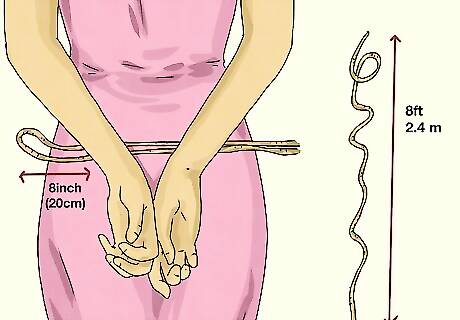
Fold a rope in half and slide it underneath your partner’s wrists. The folded, curved end of the rope is called a bight. Maneuver the bight underneath your partner’s wrists so it protrudes to one side. Leave at least about 8 in (20 cm) sticking out so you have enough rope left to tie a knot later. Use a rope that’s about 8 ft (2.4 m) long so you have plenty to work with once you fold it in half.
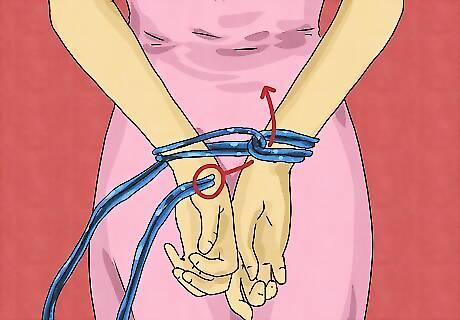
Wrap the loose (working) ends of the rope around their wrists 2 times. Hold the bight in place and coil the ends of the rope around your partner’s wrists, laying each coil of rope next to the previous one instead of stacking the coils on top of each other. Wrap the rope securely, but not so tight that it cuts off circulation or feels extremely uncomfortable. If you have lots of excess rope, make a third loop around your partner’s wrist.

Cross the bight with the loose ends so they’re perpendicular to the rope. Grab the bight in one hand and the loose ends of the rope in the other. Pull them in toward each other like you’re about to tie them together, then cross one over the other on top of the loops of rope. Pull both ends so they extend parallel with your partner’s arms, perpendicular to the loops of rope underneath. It doesn’t matter which direction the bight or ends point (they can go either way, depending on which end lays on top when you cross them).

Wrap the loose ends around the loops securing your partner’s wrists. Grab the loose ends and feed them between your partner’s wrists while holding the bight steady. Wrap them around the front and back of the wrist cuff rope so their wrists become separated (this is called a double column tie). Wrap the loose ends around at least one fun time.
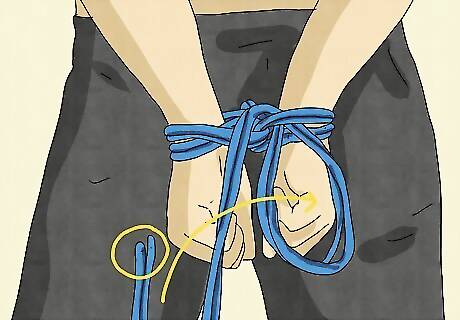
Use the rope left at the ends to tie a square knot with the bight. Hold an end of rope in each hand, then pass the right end over then under the rope in your left hand. Pass the rope end now in your left hand over then under the one now in your right. Tighten the knot by pulling both running ends at the same time. Your partner’s wrists are now securely tied, but not so tightly bound that they’re in pain or losing circulation. If the rope is too tight or too loose, undo it and start again. Practice makes perfect! If you’re struggling to rope their wrists or are concerned about circulation issues, try substituting handcuffs (they’re easier to adjust and remove).
Binding the Ankles
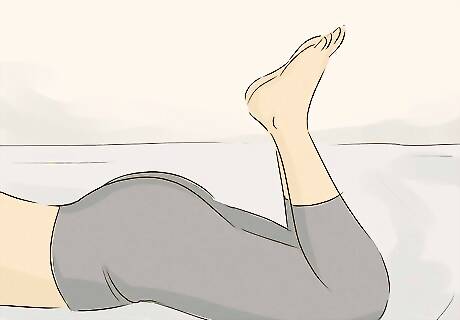
Have your partner bend their knees at a 90-degree angle. Hold their feet together so they’re touching. To make your partner more comfortable, offset the feet slightly so one is a bit more forward than the other. This way, their ankle bones won’t be smashed together when you tie them.
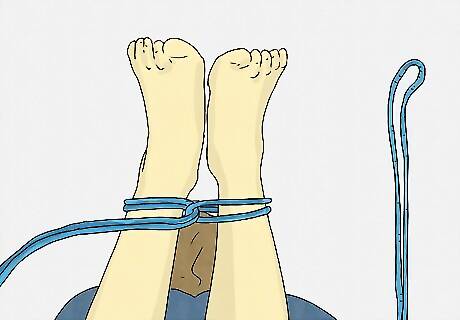
Bend the rope in half to form a bight and wrap their ankles twice. Bind your partner’s ankles the same way you bound their wrists. Leave several inches of bight protruding to one side of their ankles, then wrap the loose ends of the rope around both ankles to hold them in place. Lay each coil of rope next to the one before it instead of layering the coils on top of each other. Wrap firmly, but leave enough slack that you can easily slide 2 fingers between the rope and your partner’s skin so they don’t lose circulation.
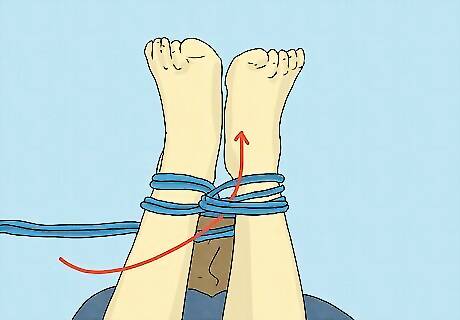
Cross the bight with the loose ends so they’re perpendicular to the rope. Grab the bight in one hand and the loose ends of the rope in the other, then pull them toward each other like you’re about to tie them together. Cross one on top of the other and pull them in opposite directions to form a cross sign with the looped rope around your partner’s ankles. Pull both ends so they extend parallel with your partner’s legs.
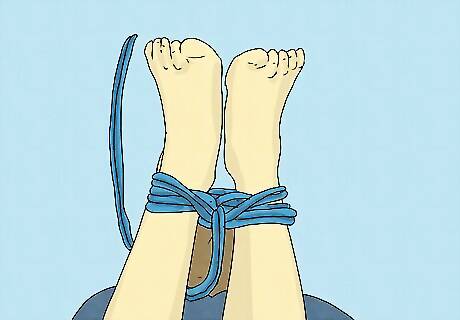
Feed the bight between their ankles and wrap it around the rope. Similarly to how you bound your partner’s wrists, wrap the bite around the loops of rope securing their ankles 1 or 2 times (depending on how much rope you have to spare). This creates another double column tie where each ankle sits in its own cuff of rope.
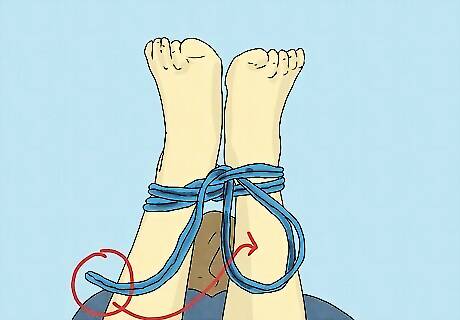
Knot the bight and the loose ends to complete the tie. With the remaining length of bight, tie another square knot in front of your partner’s ankles. Their feet are now securely bound, but not so tight to cause a lot of discomfort or pain. The bight can point up or down, depending on which way you tie it. If the rope is too tight or too loose, undo your tie and start again to make sure your partner is comfortable. If you’re struggling to tie up their ankles or are worried about circulation, try experimenting with handcuffs (they’re faster to adjust and remove).
Tying the Wrists & Ankles Together
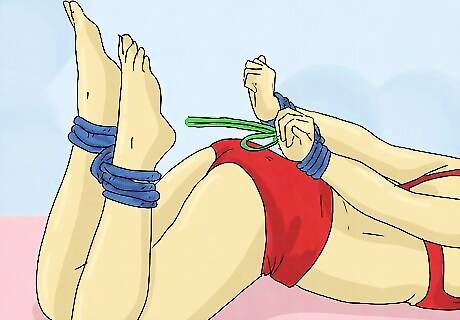
Make a bight with a separate rope and loop it around the wrist cuff. Bend your rope in half, then feed the bight end inside one wrist cuff, alongside the wrist (it doesn’t matter which one you start with). Once it’s through, reverse the direction of the bight and feed it the opposite way alongside the other wrist so it wraps around the dividing rope between your partner’s wrists. Once the bight is through, feed the working end of the rope through it and cinch it tight to secure it around the wrist cuff.
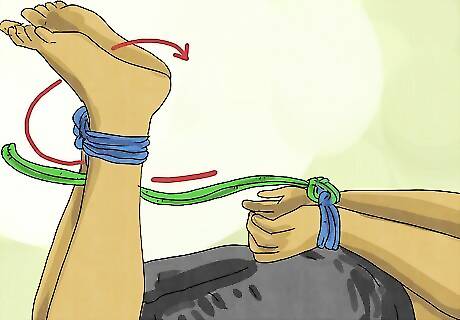
Loop the loose ends of the rope around the outside of the foot cuff. Wrap the working end of the rope around the rope between your partner’s ankles. If they’re new to hogtying or bondage, leave plenty of slack between their ankles and wrists so they’re comfortable. If they’re experienced and comfortable with it, pull their ankles and wrists closer together. Loop the rope at least once to hold the ankles in place. Add as many additional loops as you can, but leave enough spare rope to tie your finishing knot.
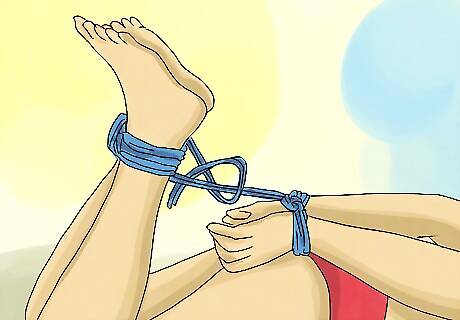
Make a knot with the excess rope from your binding and ankle ropes. Once you’ve wrapped your binding rope around the ankle rope, use what’s left to tie an overhand knot, a square knot, or whatever knot is easiest with the length of rope you have left hanging from the ankle cuff. Ask your partner if they’re comfortable with the slack between their ankles and wrists. Make sure your partner can breathe comfortably once their wrists and ankles are connected. If their breath is labored, increase the slack on the binding rope. If there’s not enough slack, undo your knot and lengthen the amount of rope between their ankles and wrists. Then, re-tie the final knot to finish the hogtie.
Safety Considerations

Use jute or natural fiber rope at least 5-7 mm (0.2-0.3 in) in diameter. Stay away from thinner ropes since these can cut into the skin and affect circulation. Rope is the most common option, but opt for cotton or silk materials if they feel better on your partner’s skin. Stay away from nylons, scarves, or low-quality handcuffs. These could cut off circulation or even cause nerve damage. If you’re new to bondage, try using handcuffs around the wrists and ankles instead of rope. They’re easier to remove in case your partner needs a break.

Keep ropes loose enough to put 2 fingers between them and the skin. This is secure enough to bind them, but loose enough to ensure good circulation. Watch out for skin discoloration, tingling sensations, or cold skin that signal circulatory problems. If your partner experiences any of these symptoms, stop immediately and untie or cut the ropes so they can recover.
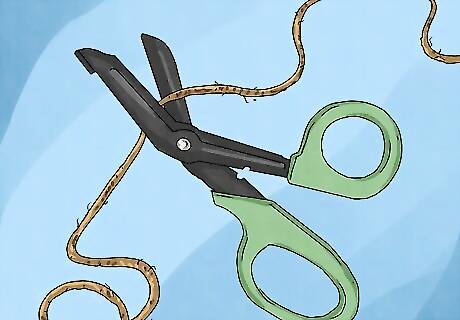
Use EMT scissors to release your partner quickly in emergencies. If your partner is in distress (physically or emotionally) during play or if there’s an emergency, like a fire alarm going off, cut them out of the ropes immediately. Remember that ropes can be replaced easily, but your partner (or their trust) can’t!

Set boundaries and expectations with your partner beforehand. Communicate with each other about what you’re comfortable with before tying anyone up. Be honest about the roles each of you wants to explore and what you’re comfortable experimenting with. Bondage and BDSM play depends on mutual trust, so make sure you’re on the same page from the very beginning.
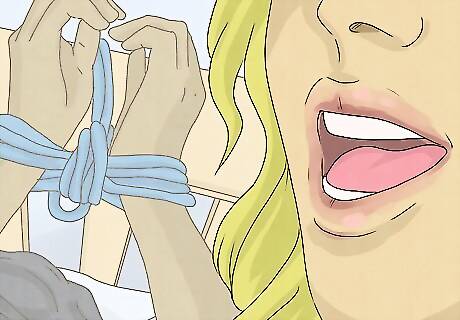
Establish a safe word before bondage play. Select a word that won’t come up in normal banter or dirty talk that your partner can use to signal they need a break or that you’ve crossed a boundary. Honor the safe word and check in with them when you hear it to make sure their needs are being met. Consider a second safe word ti indicate your partner is close to their limit, but not there yet. This lets you know to ease off or try something else.



















Comments
0 comment